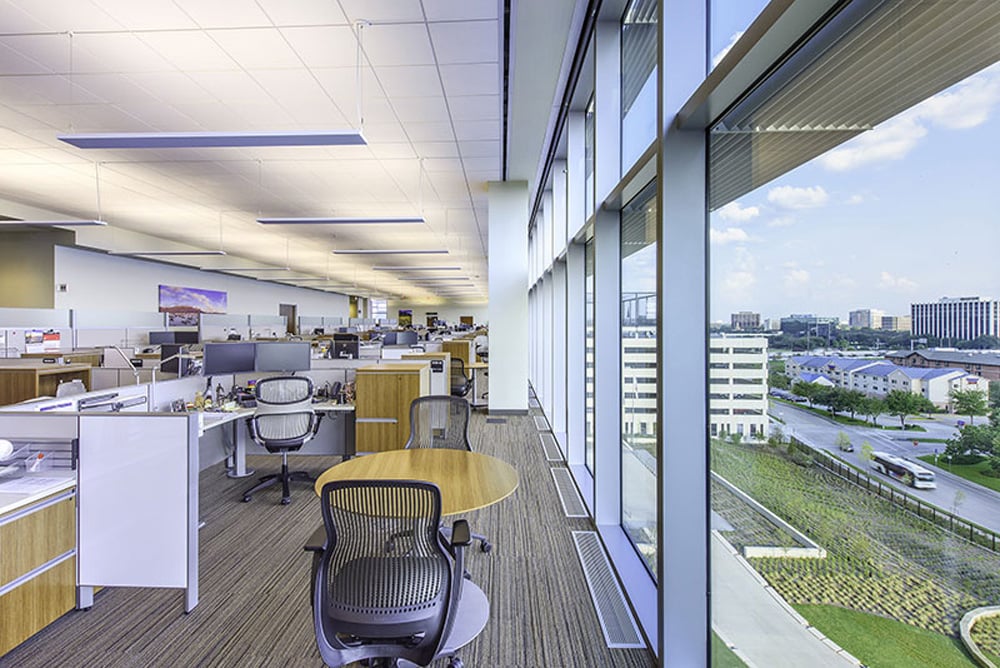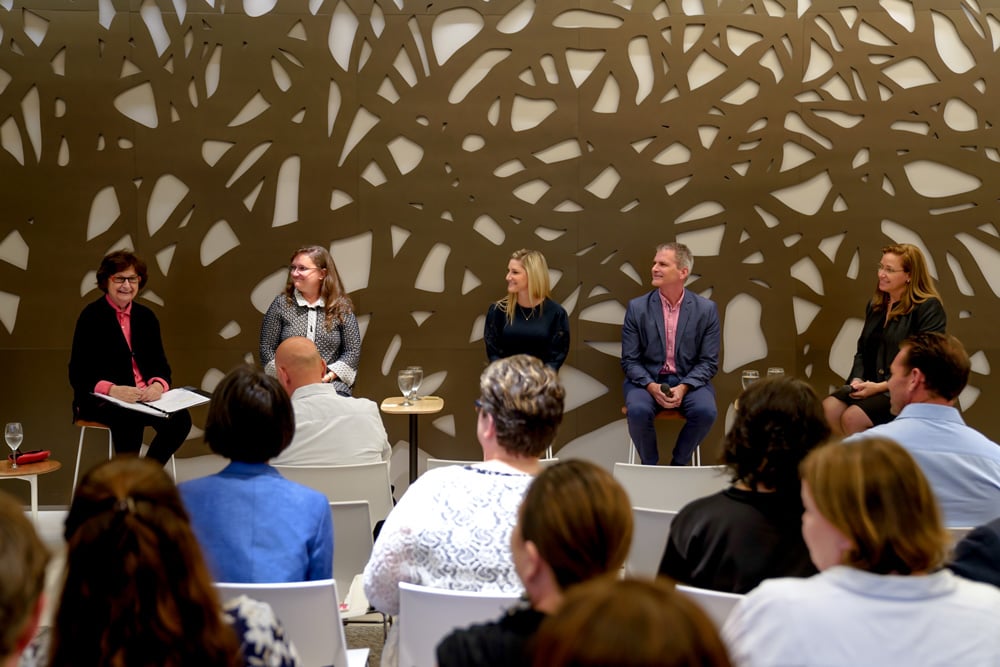
October 23, 2018
A Healthy Return: The Business Case for Well-Being in the Workplace
Haworth’s Houston showroom hosts an expert panel on designing offices that support today’s workers.
On October 10, 2018, Susan S. Szenasy, Metropolis’ director of design innovation, sat down with a panel of design experts at the Haworth showroom in Houston to discuss how workplace design has emerged as a potent factor to attract the best candidates and keep employees thriving and engaged in a company’s mission.
The panel included Stephanie Burritt, co-managing director at Gensler, Jeannine Goldsmith, project interior designer at Jacobs, Kim Sauvageau, global workplace architect at Royal Dutch Shell, and Jeff Reuschel, global director of design and innovation at Haworth. What follows is a transcript of that conversation, edited for clarity by Mia Nacamulli.
Susan S. Szenasy (SSS): With work across many cultures and economies, how does Shell approach the idea of wellness in the workplace?
Kim Sauvageau (KS): Our corporate values have themes about increasing awareness to incorporate wellness into the workplace. Cultural differences may make some solutions inappropriate, so we talk to people to get feedback on what works locally.
SSS: Stephanie, with Gensler, you observed that the concern with wellness is everywhere – we increasingly care about the human element.
Stephanie Burritt (SB): Wellness has progressed beyond something you do because it’s good for the employee or beneficial to an insurance policy, to a point of being expected across all industries. Consider some of the things we’ve been doing from a sustainability front. Daylight harvesting, for instance, is beneficial for energy consumption, but it also helps regulate daylight levels for people sitting along the perimeter of a space. What might have been a sustainability discussion at one point is now about wellness.

SSS: Jeff, what are your observations on the importance of having personal space?
Jeff Reuschel (JR): I have always thought we were on the cusp of putting the occupant first. But I do worry about people who are unassigned: We all use environment to help us with memory, and I would argue some of our practices right now are causing memory loss.
SB: The notion of work environment impacting memory loss is very new. But if we analyze why someone would choose to leave their workplace and work from home, we see a sense of familiarity and a response to the variety of space.
SSS: The real estate at Shell reflects an interest in employees experiencing a variety of spaces. Has Shell ever embraced the idea of working from home?
KS: We have more employees with flexible arrangements than with work-at-home contracts. Research shows that people coming into the office five days a week aren’t necessarily more productive compared to employees who are working to meet their business needs with flexibility.
SB: For us, it revolves around building community. Even technology that supports interacting virtually is never the same as having face-to-face meetings. Also, there are many ramifications beyond the design piece: What if somebody working from home has an ailment from using the wrong kind of chair, or has separation anxiety from having worked in isolation for too long?

SSS: Jeannine, how does this experience translate to government work?
Jeannine Goldsmith (JG): The government has specific standards and it can take a long time for trends to catch on within a government entity. If they grow, it can be a complicated transition space-wise, so perhaps working from home could actually work best within their model.
SSS: Is there a process for consulting with specialists in order to do the best job that you can for each client?
SB: We drill into the project, determine if a particular expert is needed, and assess whether the project can support that.
KS: At Shell, we have resources in-house who screen different studies, analyzing their validity and asking probing questions. If they advise us to bring in additional specialists, we document it so the next project can build upon that knowledge.
SSS: How does a design group respond to today’s evolving, volatile workplace?

KS: Having controversial discussions earlier helps address issues and move forward. Agreeing on business drivers up front and continuously referencing them also helps continue the design that aligns with what you’re trying to accomplish.
SB: As a designer, change is my friend, but I do wish I could predict the impact of what we’re doing now in the work environments and how it will inform the next big movement within design.
SSS: Jeff, how did an analog version inform your vision of Bluescape?
JR: We had hired people who understood the human brain and memory. Initially, it was a matter of putting pins on a bulletin board and being able to shuffle them to see everything at once. Had we not understood the importance of solving complex problems with all information simultaneously – not serially like on a laptop – we never would have conceived it.
SSS: How does Gensler apply its extensive data on people’s behavior under different circumstances in the increasingly refined area of wellness?
SB: For any project type, we model the experience with wellness as an embedded component. Whether the kind of food being served or green space to grow vegetables, employees are engaged participants in the space. And each project is, ultimately, a reflection of the culture of its project team or client. We help build the environment, and encourage our clients to allow their employees or consumers to behave in certain ways.

AUDIENCE MEMBER 1: In design solutions, there can be a lack of time to digest information and respond thoughtfully and deliberately. How do you ensure design decisions will be the right decisions in the future?
SB: It’s a matter of relying on experts, doing sufficient research, and then looking for the trend. With the tremendous amount of data available, it’s important to evaluate before taking a step.
JR: As with ergonomics, a well-practiced concept eventually becomes a given. If there is sustained interest, a trend becomes automatic.
AUDIENCE MEMBER 2: Your designs influence beyond the client and may be imitated to project a certain image. If a client approaches you requesting “the Google space,” for instance, do you question what they are trying to accomplish and how it enhances their business?
JG: It would not be beneficial to any client to solve a problem they don’t have. If collaboration isn’t their intention, then you would probably not guide towards a Google model, for example. Each company has its own identity and culture, and our job is to enhance it.
SB: Clients sometimes have a preconceived list of notions about what they want, often due to pressures with time, space, leadership, or budget. Whatever the driver, if you can understand the “why” and you let that inform the “what,” it’s a great way to start.

This Q&A is the third installment of our panel series “A Healthy Return: The Business Case for Wellbeing in the Workplace.” To catch up see Part 1 and Part 2.





